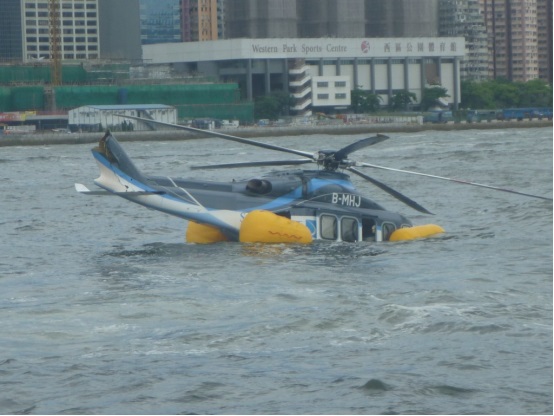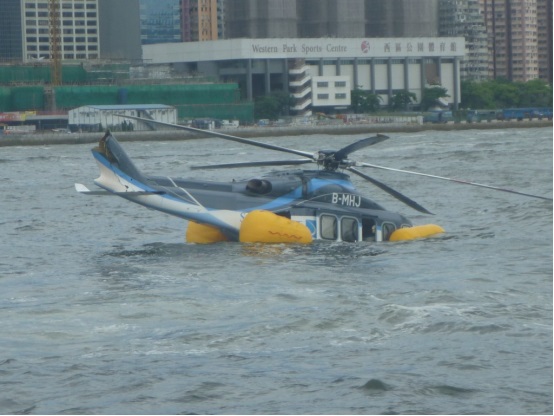Aviation News - Mini Lesson
Helicopter emergency ditching demonstrates importance of crew training and investigation procedures

3rd July 2010
Professional language training for aviation careers
Copyright 2025 Aviation English Asia Ltd. All rights reserved.
TRUE/FALSE
Read the headline and predict if these statements are true (T) or false (F):
- The helicopter experienced engine failure during the emergency. T/F
- The tail rotor completely separated from the aircraft. T/F
- All occupants evacuated safely from the water. T/F
- The emergency occurred at 350 feet altitude. T/F
- Manufacturing defects caused the tail rotor failure. T/F
- Similar accidents occurred in other countries. T/F
- The investigation used advanced forensic techniques. T/F
- No safety improvements resulted from the investigation. T/F
THE ARTICLE
Successful Helicopter Emergency Ditching Following Tail Rotor Failure
An Agusta Westland AW139 helicopter successfully executed an emergency ditching in Victoria Harbour after experiencing catastrophic tail rotor failure during climb. The aircraft was operating a scheduled passenger service from Hong Kong to Macao when the tail rotor assembly completely separated at 350 feet altitude.
The two-pilot crew immediately recognized the emergency when they heard a loud mechanical noise from the aircraft's rear, followed by severe vibration and complete loss of anti-torque control. The commander quickly initiated autorotation procedures while the first officer shut down both engines, demonstrating effective crew resource management.
The helicopter achieved a controlled ditching in level attitude with low forward speed. Emergency flotation bags inflated automatically upon water contact, providing buoyancy for evacuation. All eleven passengers and two crew members evacuated safely, with only three passengers sustaining minor injuries.
A comprehensive investigation by Hong Kong's Civil Aviation Department utilized advanced forensic techniques including optical microscopy and 3-D X-ray tomography. The investigation revealed significant manufacturing defects in the tail rotor blade construction, specifically porosity, delaminations, and dimensional non-compliance with design specifications.
Similar accidents occurred with AW139 helicopters in Qatar and Brazil during the investigation period, indicating systematic manufacturing problems. International cooperation between European aviation authorities and AgustaWestland resulted in comprehensive safety actions including mandatory blade inspections, revised manufacturing specifications, and improved quality control procedures.
The investigation employed sophisticated analysis methods to understand composite material failure mechanisms. Findings led to development of an improved blade design that restored original safety margins and operational reliability across the global AW139 fleet.
SYNONYM MATCH
(The words in bold are from the news article.)
- catastrophic a. serious
- executed b. carried out
- initiated c. started
- comprehensive d. complete
- forensic e. investigative
- delaminations f. layer separations
- systematic g. organized
- sophisticated h. advanced
- mechanisms i. processes
- reliability j. dependability
PHRASE MATCH
- tail rotor a. flotation bags
- emergency b. failure
- crew resource c. ditching
- emergency d. management
- manufacturing e. techniques
- forensic f. defects
- safety g. actions
- improved h. design
COMPREHENSION QUESTIONS
Answer these questions about the article:
- What type of helicopter was involved in the emergency?
- What route was the helicopter flying when the emergency occurred?
- At what altitude did the tail rotor fail?
- What emergency procedure did the commander initiate?
- How many people were on board the helicopter?
- How many passengers were injured?
- Which authority conducted the investigation?
- What manufacturing problems were identified?
- In which other countries did similar accidents occur?
- What safety improvements resulted from the investigation?
DISCUSSION – STUDENT A
Discuss these questions with your partner:
a) What do you think about the crew's response to this emergency?
b) How important is crew resource management in aviation emergencies?
c) What role do emergency flotation systems play in helicopter safety?
d) How significant are manufacturing quality control issues in aviation?
e) What can be learned from international cooperation in safety investigations?
f) How do advanced forensic techniques improve aviation safety?
g) What emergency training should helicopter pilots receive?
h) How can manufacturers prevent systematic quality problems?
DISCUSSION – STUDENT B
Discuss these questions with your partner:
a) What do you know about helicopter autorotation procedures?
b) How do tail rotor failures affect helicopter control?
c) What factors contribute to successful emergency ditching?
d) How important is rapid evacuation in water emergencies?
e) What role should certification authorities play in manufacturing oversight?
f) How can composite material failures be prevented?
g) What lessons can civilian aviation learn from this investigation? h) What questions would you ask the investigation team about their findings?
SPELLING
Correct the spelling of these words from the article:
- catastrofic tail rotor failure
- succesfully executed emergency ditching
- recogniced the emergency condition
- autorotasion procedures for helicopters
- flotasion bags inflated automatically
- comprehensiv investigation by authorities
- forenzic techniques for analysis
- manufactering defects in blade construction
- delaminations in composite materials
- sistematic manufacturing problems
- sofisticated analysis methods
- reliabilty across global fleet
SPEAKING – EMERGENCY PRIORITIES
Rank these factors in emergency management. Put the most important at the top:
• Crew resource management
• Emergency procedure training
• Aircraft system knowledge
• Passenger evacuation procedures
• Emergency equipment effectiveness
• Investigation thoroughness
• Manufacturing quality control
• International safety cooperation
ANSWERS
True/False: 1-F, 2-T, 3-T, 4-T, 5-T, 6-T, 7-T, 8-F
Synonym Match: 1-a, 2-b, 3-c, 4-d, 5-e, 6-f, 7-g, 8-h, 9-i, 10-j
Phrase Match: 1-b, 2-c, 3-d, 4-a, 5-f, 6-e, 7-g, 8-h
Comprehension Questions:
- Agusta Westland AW139
- Hong Kong to Macao
- 350 feet altitude
- Autorotation procedures
- 13 people (11 passengers, 2 crew)
- Three passengers
- Hong Kong Civil Aviation Department
- Porosity, delaminations, dimensional non-compliance
- Qatar and Brazil
- Mandatory inspections, revised specifications, improved quality control
Spelling: 1-catastrophic, 2-successfully, 3-recognized, 4-autorotation, 5-flotation, 6-comprehensive, 7-forensic, 8-manufacturing, 9-delaminations, 10-systematic, 11-sophisticated, 12-reliability


.jpg)